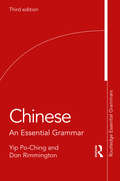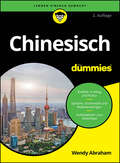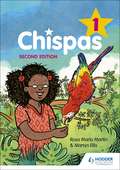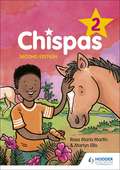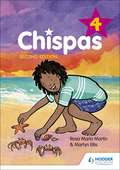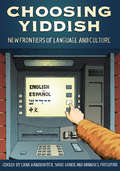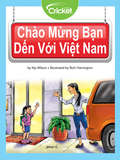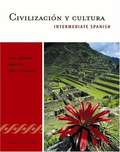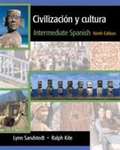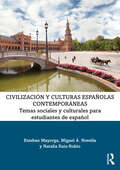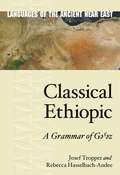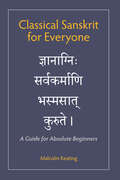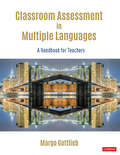- Table View
- List View
Chinese: An Essential Grammar (Routledge Essential Grammars)
by Yip Po-Ching Don RimmingtonThis new and extended edition of Chinese: An Essential Grammar is an up-to-date and concise reference guide to modern Chinese (Mandarin) grammar. Refreshingly jargon-free, it presents an accessible description of the language, focusing on the real patterns of use today. This Grammar aims to serve as a reference source for the learner and user of Chinese, irrespective of level, setting out the complexities of the language in short, readable sections. It is ideal either for independent study or for students in schools, colleges, universities and adult classes of all types. Features include: Three new chapters on speech habits, writing conventions and new lexicalisation processes Chinese characters, as well as the pinyin romanisation, alongside all examples Literal and colloquial translations into English to illustrate language points Detailed contents list and index for easy access to information A glossary of grammatical terms.
Chinesisch Sprechen und Schreiben für Dummies (Für Dummies)
by Jing Li Wendy AbrahamEinfach Chinesisch lernen Dieses Buch bietet einen leichten Einstieg in die chinesische Sprache und die Schriftzeichen. Sie lernen die chinesische Grammatik, die richtige Betonung und das Meistern von Alltagssituationen: sich auf Chinesisch vorstellen, etwas beschreiben, telefonieren oder ein Hotelzimmer reservieren. Begleitende Dialoge finden Sie online als Audiodateien zum Anhören und Nachsprechen. Außerdem lernen Sie erste Schriftzeichen kennen und können diese mit einfachen Schreibanleitungen üben. Im Anhang des Buches finden Sie Verb-Tabellen und ein kleines Chinesisch-Deutsch-/Deutsch-Chinesisch-Wörterbuch. Sie erfahren Was es mit den vier Tönen auf sich hat Wie Sie sich im Alltag zurechtfinden Was Sie über die Kultur in China wissen sollten Wie sich chinesische Schriftzeichen zusammensetzen
Chinesisch für Dummies (Für Dummies)
by Wendy AbrahamVon Guten Tag bis Auf Wiedersehen: von nǐ hǎo bis zài jiàn Mit diesem Buch lernen Sie Chinesisch sprechen. Los geht’s mit einer Einführung in die Besonderheiten der chinesischen Sprache, in die Betonung sowie in die Grammatik. Dann wird es auch schon praktisch: Sie lernen, wie Sie sich auf Chinesisch vorstellen, etwas beschreiben, telefonieren oder ein Hotelzimmer reservieren. Dabei lernen Sie die wichtigsten Sätze, Umschreibungen und Begriffe, kombiniert mit Informationen zur chinesischen Kultur. Mit kleinen übungen, Verbtabellen, dem im Buch enthaltenen Wörterbuch und den Audiodateien zum Buch können Sie Ihre Sprachkenntnisse festigen. Sie erfahren Welche Besonderheiten der chinesischen Sprache und Kultur Sie kennen sollten Was Sie bei der Aussprache und Betonung beachten sollten Wie Sie auf Chinesisch einkaufen
Chispas Level 1 2nd edn
by Rosa Maria Martin Martyn EllisA primary Spanish course that fosters active communication through the teaching of everyday vocabulary and structures that children can immediately use to talk about their own lives. - Introduces children to Spanish using songs, activities and reinforcement exercises- Develops speaking and listening skills through the use of simple audio texts with visuals- Presents clear lesson objectives and displays new words in attractive Word Boxes- Includes Grammar Boxes which take children through new grammar points they ha ve learned- Provides a variety of stimulating activities, using co-operative learning- Easy to use by both specialist and non-specialist teachers.- Ensure affective use of the series with free teacher's notes available at www.hoddereducation.co.uk/chispas-teachers
Chispas Level 2 2nd edn
by Rosa Maria Martin Martyn EllisA primary Spanish course that fosters active communication through the teaching of everyday vocabulary and structures that children can immediately use to talk about their own lives. - Introduces children to Spanish using songs, activities and reinforcement exercises- Develops speaking and listening skills through the use of simple audio texts with visuals- Presents clear lesson objectives and displays new words in attractive Word Boxes- Includes Grammar Boxes which take children through new grammar points they ha ve learned- Provides a variety of stimulating activities, using co-operative learning- Easy to use by both specialist and non-specialist teachers.- Ensure affective use of the series with free teacher's notes available at www.hoddereducation.co.uk/chispas-teachers
Chispas Level 3 2nd edn
by Rosa Maria Martin Martyn EllisA primary Spanish course that fosters active communication through the teaching of everyday vocabulary and structures that children can immediately use to talk about their own lives. - Introduces children to Spanish using songs, activities and reinforcement exercises- Develops speaking and listening skills through the use of simple audio texts with visuals- Presents clear lesson objectives and displays new words in attractive Word Boxes- Includes Grammar Boxes which take children through new grammar points they ha ve learned- Provides a variety of stimulating activities, using co-operative learning- Easy to use by both specialist and non-specialist teachers.- Ensure affective use of the series with free teacher's notes available at www.hoddereducation.co.uk/chispas-teachers
Chispas Level 4 2nd edn
by Rosa Maria Martin Martyn EllisA primary Spanish course that fosters active communication through the teaching of everyday vocabulary and structures that children can immediately use to talk about their own lives. - Introduces children to Spanish using songs, activities and reinforcement exercises- Develops speaking and listening skills through the use of simple audio texts with visuals- Presents clear lesson objectives and displays new words in attractive Word Boxes- Includes Grammar Boxes which take children through new grammar points they ha ve learned- Provides a variety of stimulating activities, using co-operative learning- Easy to use by both specialist and non-specialist teachers.- Ensure affective use of the series with free teacher's notes available at www.hoddereducation.co.uk/chispas-teachers
Choosing Yiddish: New Frontiers of Language and Culture
by Dara Horn Jeffrey Shandler Jeremy Dauber Josh Lambert Barbara Kirshenblatt-Gimblett Kalman Weiser Hasia Diner Ari Y. Kelman Tony Michels Gennady Estraikh Sarah Bunin Benor Anita Norich Rebecca Margolis Zehavit Stern Asya Vaisman Shiri Goren Lara Rabinovitch Gerben Zaagsma Edward Portnoy Jennifer Young Ela Bauer Shachar Pinsker Shayn Smulyan Adriana X. Jacobs Barbara Mann Jordan Finkin Rebecca Kobrin Hannah S. Pressman Anna ShternshisYiddish Hip Hop, a nineteenth-century "Hasidic Slasher," obscure Yiddish writers, and immigrant Jewish newspapers in Buenos Aires, Paris, and New York are just a few of the topics featured in Choosing Yiddish: New Frontiers of Language and Culture. Editors Lara Rabinovitch, Shiri Goren, and Hannah S. Pressman have gathered a diverse and richly layered collection of essays that demonstrates the currency of Yiddish scholarship in academia today.Organized into six thematic rubrics, Choosing Yiddish demonstrates that Yiddish, always a border-crossing language, continues to push boundaries with vigorous disciplinary exchange. "Writing on the Edge" focuses on the realm of belles lettres; "Yiddish and the City" spans the urban centers of Paris, Buenos Aires, New York City, and Montreal; "Yiddish Goes Pop" explores the mediating role of Yiddish between artistic vision and popular culture; "Yiddish Comes to America" focuses on the history and growth of Yiddish in the United States; "Yiddish Encounters Hebrew" showcases interactions between Yiddish and Hebrew in the late nineteenth and twentieth centuries; and "Hear and Now" explores the aural dimension of Yiddish in contemporary settings. Along the way, contributors consider famed and lesser-known Yiddish writers, films, and Yiddish hip-hop, as well as historical studies on the Yiddish press, Yiddish film melodrama, Hasidic folkways, and Yiddish culture in Israel. Venerable scholars introduce each rubric, creating additional dialogue between newer and more established voices in the field.The international contributors prove that the language--far from dying--is fostering exciting new directions of academic and popular discourse, rooted in the field's historic focus on interdisciplinary research. Students and teachers of Yiddish studies will enjoy this innovative collection.
Christian Faith and English Language Teaching and Learning: Research on the Interrelationship of Religion and ELT
by Zoltán Dörnyei Mary Shepard Wong Carolyn KristjánssonIdeological and educational-political aspects of the link between language and faith—especially between Global English and Christianity—is a topic of growing interest in the field of English language teaching. This book explores the possible role and impact of teachers’ and students’ faith in the English language classroom. Bringing together studies representing a diversity of experiences and perspectives on the philosophies, purposes, practices, and theories of the interrelationship of Christianity and language learning and teaching, it is on the front line in providing empirical data that offers firm insights into the actual role that faith plays in various aspects of the language learning/teaching experience. By adding a data-based dimension, the volume contributes to the cultivation of valid research methods and innovative ways to analyze and interpret studies of the intersection of Christian faith and the practice of teaching and learning language. .
Christian and Critical English Language Educators in Dialogue: Pedagogical and Ethical Dilemmas
by Suresh Canagarajah Mary Shepard WongThe legacy of English teaching and Christian missionaries is a flashpoint within the field of English language teaching. This critical examination of the place of Christianity in the field is unique in presenting the voices of TESOL professionals from a wide range of religious and spiritual perspectives. About half identify themselves as "Christian" while the others identify themselves as Buddhist, atheist, spiritualist, and variations of these and other faiths. What is common for all the authors is their belief that values have an important place in the classroom. What they disagree on is whether and how spiritual values should find expression in learning and teaching. This volume dramatizes how scholars in the profession wrestle with ideological, pedagogical, and spiritual dilemmas as they seek to understand the place of faith in education. To sustain this conversation, the book is structured dialogically. Each section includes a set of position chapters in which authors explain their views of faith/pedagogy integration, a set of chapters by authors responding to these positions while articulating their own views on the subject, and discussion questions to engage readers in comparing the positions of all the authors, reflecting on their own experiences and values, and advancing the dialogue in fresh and personal directions.
Chào Mừng Bạn Dến Với Việt Nam
by Kip WilsonA young girl and her parents visit the foreign country of Vietnam. While exploring Ho Chi Minh City, the girl's parents test her knowledge of the Vietnamese language, including "hello," "please," "thank you," and "goodbye."
Cinderella/Cenicienta (Bilingual Fairy Tales #Bili)
by Francesc Boada Monse Fransoy James SurgesStriking art gives this classic fairy tale a fresh look that will enchant a new generation of readers. Retold in both Spanish and English, this universally familiar story is now a springboard to inspire readers to recognize words in both languages. The dual-language text makes this book a useful and beautiful addition to both home and classroom libraries.
Cinema and Contact: The Withdrawal of Touch in Nancy, Bresson, Duras and Denis
by Laura McMahonDrawing on the work of contemporary French philosopher Jean-Luc Nancy, Cinema and Contact investigates the aesthe-tics and politics of touch in the cinema of three of the most prominent and distinctive filmmakers to have emerged in France during the last fifty years: Robert Bresson, Marguerite Duras and Claire Denis. Countering the domi-nant critical account of touch elaborated by recent models of embodied spectatorship, this book argues that cinema offers a privileged space for understanding touch in terms of spacing and withdrawal rather than immediacy and continuity. Such a deconstructive configuration of touch is shown here to have far-reaching implications, inviting an innovative rethinking of politics, aesthetics and theology via the textures of cinema. The first study to bring the thought of Nancy into sustained dialogue with a series of detailed analyses of films, Cinema and Contact also forges new interpretative perspectives on Bresson, Duras and Denis, tracing a compelling two-way exchange between cinema and philosophy.
City & Guilds 3850: English for Caribbean Schools
by Sharon Ann StarkDevelop the reading, writing, speaking and listening skills needed to succeed with the only resource written specifically for the Caribbean region and published in association with City & Guilds.This resource is ideal for students, trainees and adults who desire to improve their language skills whether in preparation for further education or for employment opportunities.- Thoroughly and systematically explore topics across each level with clear explanations, worked examples, tasks and test your knowledge multiple choice activities.- Focus your learning on the key concepts and strategies with learner tips and helpful reminders throughout. - Provides comprehensive coverage of all three certification levels, with content written by experienced examiners. -Get exam ready with clear objectives which indicate the skills to be developed and the areas of the examination targeted. -Improve language skills with everyday transactional uses of English.
City & Guilds 3850: English for Caribbean Schools
by Sharon Ann StarkDevelop the reading, writing, speaking and listening skills needed to succeed with the only resource written specifically for the Caribbean region and published in association with City & Guilds.This resource is ideal for students, trainees and adults who desire to improve their language skills whether in preparation for further education or for employment opportunities.- Thoroughly and systematically explore topics across each level with clear explanations, worked examples, tasks and test your knowledge multiple choice activities.- Focus your learning on the key concepts and strategies with learner tips and helpful reminders throughout. - Provides comprehensive coverage of all three certification levels, with content written by experienced examiners. -Get exam ready with clear objectives which indicate the skills to be developed and the areas of the examination targeted. -Improve language skills with everyday transactional uses of English.
Civilizacion y Cultura Intermediate Spanish (8th edition)
by Ralph Kite Lynn A. Sandstedt John G. CopelandCIVILIZACION Y CULTURA, Eighth Edition, part of a complete intermediate series, offers readers twelve units that combine a thematic and historical approach which introduces students to traditional cultural topics and daily life issues found throughout the Hispanic world.
Civilización y cultura: Intermediate Spanish
by Lynn Sandstedt Ralph KiteThe readings in each unit of CIVILIZACION Y CULTURA match the thematic content of the units of the main book, CONVERSACION Y REPASO. There is better correlation of these supplementary books in marginal annotations on each unit-opening and unit-closing page.
Civilización y culturas españolas contemporáneas: Temas sociales y culturales para estudiantes de español
by Miguel Á. Novella Esteban Mayorga Natalia Ruiz-RubioCivilización y culturas españolas contemporáneas: temas sociales y culturales para estudiantes de español presenta a los estudiantes de español de nivel intermedio a avanzado las complejas realidades de la España contemporánea mediante crónicas.A través de una colección cuidadosamente seleccionada de piezas periodísticas de no ficción, los estudiantes conocerán temas clave como la inmigración y los conflictos sociales, la identidad, la raza y el género, así como la gastronomía y la cultura popular. Al final del libro, los estudiantes tendrán una comprensión más profunda de las fuertes cuestiones políticas, lingüísticas y culturales que han dado forma a la España contemporánea. El libro contiene una gran cantidad de textos que se centran en temas de relevancia global y a la vez resaltan la diversidad de la España contemporánea. Cada texto va acompañado de una combinación de preguntas de comprensión y análisis para reforzar el aprendizaje.El libro se puede utilizar como texto básico para cursos de “civilización española” o como lectura complementaria para cualquier curso de español de nivel intermedio a avanzado.
Classical Arabic Literature: A Library of Arabic Literature Anthology (Library of Arabic Literature #5)
by Geert Jan GelderA major translation achievement, this anthology presents a rich assortment of classical Arabic poems and literary prose, from pre-Islamic times until the eighteenth century, with short introductions to guide non-specialist students and informative endnotes and bibliography for advanced scholars. Both entertaining and informative, Classical Arabic Literature ranges from the early Bedouin poems with their evocation of desert life to refined urban lyrical verse, from tender love poetry to sonorous eulogy and vicious lampoon, and from the heights of mystical rapture to the frivolity of comic verse. Prose selections include anecdotes, entertaining or edifying tales and parables, a fairy-tale, a bawdy story, samples of literary criticism, and much more.With this anthology, distinguished Arabist Geert Jan van Gelder brings together well-known texts as well as less familiar pieces new even to scholars. Classical Arabic Literature reveals the rich variety of pre-modern Arabic social and cultural life, where secular texts flourished alongside religious ones. This masterful anthology introduces this vibrant literary heritage—including pieces translated into English for the first time—to a wide spectrum of new readers. An English-only edition.
Classical Chinese for Everyone: A Guide for Absolute Beginners
by Bryan W. Van NordenIn just thirteen brief, accessible chapters, this engaging little book takes "absolute beginners" from the most basic questions about the language (e.g., what does a classical Chinese character look like?) to reading and understanding selections from classical Chinese philosophical texts and Tang dynasty poetry. "An outstanding introduction to reading classical Chinese. Van Norden does a wonderful job of clearly explaining the basics of classical Chinese, and he carefully takes the reader through beautifully chosen examples from the textual tradition. An invaluable work." —Michael Puett, Harvard University
Classical Ethiopic: A Grammar of Gəˁəz (Languages of the Ancient Near East #10)
by Rebecca Hasselbach-Andee Josef TropperUpon its publication in 2002, Josef Tropper’s Altäthiopisch: Grammatik des Gəˁəz mit Übungstexten und Glossar was quickly recognized as the best modern grammar of Classical Ethiopic in any language. Now Eisenbrauns makes Tropper’s grammar available for the first time in English, in this revised and expanded edition by Josef Tropper and Rebecca Hasselbach-Andee.Gəˁəz literature is diverse and of major importance for the study of early Christianity, Judaism, and the history of eastern Africa. The language of this rich literature, however, has been difficult to access until now. Designed to help language learners acquire competency with the script from the start, Classical Ethiopic provides a comprehensive treatment of Gəˁəz grammar, with detailed chapters on the language’s writing system, phonology, morphology, morphosyntax, and syntax. Numerous example sentences illustrate the grammatical concepts discussed, and each example is presented in Ethiopic script, transliteration, and English translation. The grammar concludes with an appendix presenting sample texts to be used as exercises, an English-Gəˁəz glossary, and an updated bibliography that takes into account the developments that have occurred in the study of Gəˁəz in the nearly two decades since Tropper’s original publication.Appropriate for the classroom and for independent study, Classical Ethiopic is sure to become the standard reference in English for the study of the language.
Classical Ethiopic: A Grammar of Gəˁəz (Languages of the Ancient Near East)
by Rebecca Hasselbach-Andee Josef TropperUpon its publication in 2002, Josef Tropper’s Altäthiopisch: Grammatik des Gəˁəz mit Übungstexten und Glossar was quickly recognized as the best modern grammar of Classical Ethiopic in any language. Now Eisenbrauns makes Tropper’s grammar available for the first time in English, in this revised and expanded edition by Josef Tropper and Rebecca Hasselbach-Andee.Gəˁəz literature is diverse and of major importance for the study of early Christianity, Judaism, and the history of eastern Africa. The language of this rich literature, however, has been difficult to access until now. Designed to help language learners acquire competency with the script from the start, Classical Ethiopic provides a comprehensive treatment of Gəˁəz grammar, with detailed chapters on the language’s writing system, phonology, morphology, morphosyntax, and syntax. Numerous example sentences illustrate the grammatical concepts discussed, and each example is presented in Ethiopic script, transliteration, and English translation. The grammar concludes with an appendix presenting sample texts to be used as exercises, an English-Gəˁəz glossary, and an updated bibliography that takes into account the developments that have occurred in the study of Gəˁəz in the nearly two decades since Tropper’s original publication.Appropriate for the classroom and for independent study, Classical Ethiopic is sure to become the standard reference in English for the study of the language.
Classical Sanskrit for Everyone: A Guide for Absolute Beginners
by Malcolm Keating&“Surprisingly,Classical Sanskrit for Everyone is indeed for everyone. Playing tour guide to the &‘curious,&’ the &‘Yoga aficionado,&’ and the &‘scholar&’ on an efficient itinerary through Sanskrit grammar and its philosophical cultures, Keating&’s book is refreshingly accessible and useful. Replete with an excellent analysis of important features of Sanskrit with analogies to English usage and learned &‘pandit points,&’ it also provides supplemental discussions of Sanskrit poetry and philosophy and up-to-date online resources. Pop culture references and a playfully funny tone, at turns, disarm the uninitiated reader and give the scholar a fresh perspective on how to teach this language to a new generation of eager learners.&” —Deven M. Patel, University of Pennsylvania
Classroom Assessment in Multiple Languages: A Handbook for Teachers
by Margo GottliebWhat if multilingual learners had the freedom to interact in more than one language with their peers during classroom assessment? What if multilingual learners and their teachers in dual language settings had opportunities to use assessment data in multiple languages to make decisions? Just imagine the rich linguistic, academic, and cultural reservoirs we could tap as we determine what our multilingual learners know and can do. Thankfully, Margo Gottlieb is here to provide concrete and actionable guidance on how to create assessment systems that enable understanding of the whole student, not just that fraction of the student who is only visible as an English learner. With Classroom Assessment in Multiple Languages as your guide, you’ll: Better understand the rationale for and evidence on the value and advantages of classroom assessment in multiple languages Add to your toolkit of classroom assessment practices in one or multiple languages Be more precise and effective in your assessment of multilingual learners by embedding assessment as, for, and of learning into your instructional repertoire Recognize how social-emotional, content, and language learning are all tied to classroom assessment Guide multilingual learners in having voice and choice in the assessment process Despite the urgent need, assessment for multilingual learners is generally tucked into a remote chapter, if touched upon at all in a book; the number of resources narrows even more when multiple languages are brought into play. Here at last is that single resource on how educators and multilingual learners can mutually value languages and cultures in instruction and assessment throughout the school day and over time. We encourage you to get started right away. “Margo Gottlieb has demonstrated why the field, particularly the field as it involves the teaching of multilingual learners, needs another assessment book, particularly a book like this. . . . Classroom Assessment in Multiple Languages quite likely could serve as a catalyst toward the beginning of an enlightened discourse around assessment that will benefit multilingual learners.” ~Kathy Escamilla
Classroom Assessment in Multiple Languages: A Handbook for Teachers
by Margo GottliebWhat if multilingual learners had the freedom to interact in more than one language with their peers during classroom assessment? What if multilingual learners and their teachers in dual language settings had opportunities to use assessment data in multiple languages to make decisions? Just imagine the rich linguistic, academic, and cultural reservoirs we could tap as we determine what our multilingual learners know and can do. Thankfully, Margo Gottlieb is here to provide concrete and actionable guidance on how to create assessment systems that enable understanding of the whole student, not just that fraction of the student who is only visible as an English learner. With Classroom Assessment in Multiple Languages as your guide, you’ll: Better understand the rationale for and evidence on the value and advantages of classroom assessment in multiple languages Add to your toolkit of classroom assessment practices in one or multiple languages Be more precise and effective in your assessment of multilingual learners by embedding assessment as, for, and of learning into your instructional repertoire Recognize how social-emotional, content, and language learning are all tied to classroom assessment Guide multilingual learners in having voice and choice in the assessment process Despite the urgent need, assessment for multilingual learners is generally tucked into a remote chapter, if touched upon at all in a book; the number of resources narrows even more when multiple languages are brought into play. Here at last is that single resource on how educators and multilingual learners can mutually value languages and cultures in instruction and assessment throughout the school day and over time. We encourage you to get started right away. “Margo Gottlieb has demonstrated why the field, particularly the field as it involves the teaching of multilingual learners, needs another assessment book, particularly a book like this. . . . Classroom Assessment in Multiple Languages quite likely could serve as a catalyst toward the beginning of an enlightened discourse around assessment that will benefit multilingual learners.” ~Kathy Escamilla
